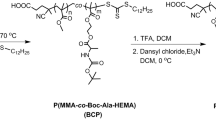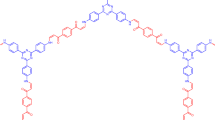Abstract
A new conjugated polymer possessing calix[4]arene-oxacyclophane units wired-in-series by phenyleneethynylene linkers was synthesized by a Sonogashira-Hagihara cross-coupling method in high yield. The polymer was structurally characterized by FTIR and 1H/13C/HSQC NMR techniques, and its average Mn (38.5 kDa) retrieved from GPC analysis. The polymer is highly emissive (ΦF = 0.55) and exhibits a longer-than-usual excited-state lifetime (1.80 ns) for a phenyleneethynylene type polymer. Similar photophysical properties (absorption and fluorescence emission) were observed in solution and in solid-state. This stems from the presence of bulky calixarene moieties along the polymer chains which prevent interchain staking and the formation of ground-state aggregates and/or non-emissive exciplexes, both deleterious to solid-state materials envisioned for fluorescence sensing applications. Moreover, the intrinsic molecular recognition capabilities of its two rigid inner cavities (calixarene and cyclophane sub-units), allied with the high three-dimensionality of the macromolecule that creates additional interstitial voids around the molecular receptors, can boost its sensory responses towards specific analytes. A high sensitive response was observed in the detection of nitroaromatics and nitroanilines in neat vapour phases by casted films of the polymer. The largest sensitivities were obtained for 2,4-dinitrotoluene (a taggant for the explosive TNT; > 85% of fluorescence quenching upon 1 min exposure) and ortho-nitroaniline (90% of emission reduction in 30 s). The sensory responses attained in solid-state are discussed on the basis of the electron affinities of the analytes and their electrostatic interactions with polymer films.

Sensing the threats! A high sensitive response was observed in the detection of explosives and noxious nitroanilines in neat vapour phases by thinfilms of a calixarene-based polymer









Similar content being viewed by others
References
Ponnu A, Anslyn EV (2010) A fluorescence-based cyclodextrin sensor to detect nitroaromatic explosives. Supramol Chem 22:65–71. https://doi.org/10.1080/10610270903378032
Zhu W, Li W, Wang C, Cui J, Yang H, Jiang Y, Li G (2013) CB[8]-based rotaxane as a useful platform for sensitive detection and discrimination of explosives. Chem Sci 4:3583–3590. https://doi.org/10.1039/c3sc51132d
Naddo T, Che Y, Zhang W, Balakrishnan K, Yang X, Yen M, Zhao J, Moore JS, Zang L (2007) Detection of explosives with a fluorescent Nanofibril film. J Am Chem Soc 129:6978–6979. https://doi.org/10.1021/ja070747q
Costa AI, Prata JV (2012) Substituted p-phenylene ethynylene trimers as fluorescent sensors for nitroaromatic explosives. Sensors Actuators B Chem 161:251–260. https://doi.org/10.1016/j.snb.2011.10.027
Bissell RA, Prasanna de Silva A, Gunaratne HQN, Lynch PLM, Maguire GEM, Sandanayake KRAS (1992) Molecular fluorescent Signalling with ‘Fluor-spacer-receptor‘ systems: approaches to sensing and switching devices via Supramolecular Photophysics. Chem Soc Rev 21:187–195. https://doi.org/10.1039/CS9922100187
Fabbrizzi L, Poggi A (1995) Sensors and switches from supramolecular chemistry. Chem Soc Rev 24:197–202. https://doi.org/10.1039/CS9952400197
Prasanna de Silva A, Gunaratne HQN, Gunnlaugsson T, Huxley AJM, McCoy CP, Rademacher JT, Rice TE (1997) Signaling recognition events with fluorescent sensors and switches. Chem Rev 97:1515–1566. https://doi.org/10.1021/cr960386p
Sun X, Wang Y, Lei Y (2015) Fluorescence based explosive detection: from mechanisms to sensory materials. Chem Soc Rev 44:8019–8061. https://doi.org/10.1039/c5cs00496a
Yang J-S, Swager TM (1998) Porous shape persistent fluorescent polymer films: an approach to TNT sensory materials. J Am Chem Soc 120:5321–5322. https://doi.org/10.1021/ja9742996
Yang J-S, Swager TM (1998) Fluorescent porous polymer films as TNT Chemosensors: electronic and structural effects. J Am Chem Soc 120:11864–11873. https://doi.org/10.1021/ja982293q
Cumming CJ, Aker C, Fisher M, Fox M, Grone MJ, Reust D, Rockley MG, Swager TM, Towers E, Williams V (2001) Using novel fluorescent polymers as sensory materials for above-ground sensing of chemical signature compounds emanating from buried landmines. IEEE Trans Geosci Remote Sens 39:1119–1128. https://doi.org/10.1109/36.927423
Andrew TL, Swager TM (2011) Structure-property relationships for Exciton transfer in conjugated polymers. J Polym Sci B Polym Phys 49:476–498. https://doi.org/10.1002/polb.22207
Costa AI, Pinto HD, Ferreira LFV, Prata JV (2012) Solid-state sensory properties of CALIX-poly(phenylene ethynylene)s toward nitroaromatic explosives. Sensors Actuators B Chem 161:702–713. https://doi.org/10.1016/j.snb.2011.11.017
Barata PD, Prata JV (2014) Cooperative effects in the detection of a Nitroaliphatic liquid explosive and an explosive Taggant in the vapor phase by calix[4]arene-based Carbazole-containing conjugated polymers. ChemPlusChem 79:83–89. https://doi.org/10.1002/cplu.201300280
Eaton DF (1998) Reference materials for fluorescence measurement. Pure Appl Chem 60:1107–1114. https://doi.org/10.1351/pac198860071107
Lakowicz JR (2006) Principles of fluorescence spectroscopy, 3rd edn. Springer, New York. https://doi.org/10.1007/978-0-387-46312-4
Spartan’14 Molecular Modeling Program (vs 1.1.8), Wavefunction, Inc., Irvine, CA, 2014
Dennis WH Jr, Rosenblatt DH, Blucher WG, Coon CL (1975) Improved synthesis of TNT isomers. J Chem Eng Data 20:202–203. https://doi.org/10.1021/je60065a016
Teixeira CM, Costa AI, Prata JV (2013) A new fluorescent double-cavity calix[4]arene: synthesis and complexation studies toward nitroanilines. Tetrahedron Lett 54:6602–6606. https://doi.org/10.1016/j.tetlet.2013.09.109
Bunz UHF (2007) Poly(paraphenyleneethynylene)s and poly(aryleneethynylenes): materials with a bright future. In: Skotheim TA, Reynolds JR (eds) Conjugated polymers. CRC Press, Boca Raton, pp 1–51
Bunz UHF (2000) Poly(aryleneethynylene)s: syntheses, properties, structures, and applications. Chem Rev 100:1605–1644. https://doi.org/10.1021/cr990257j
Barata PD, Costa AI, Ferreira LFV, Prata JV (2010) Synthesis, structure, and optical properties of an alternating calix[4]arene-based meta-linked Phenylene Ethynylene copolymer. J Polym Sci A Polym Chem 48:5040–5052. https://doi.org/10.1002/pola.24302
Barata PD, Prata JV (2013) New entities for sensory chemistry based on calix[4]arene-carbazole conjugates: from synthesis to applications. Supramol Chem 25:782–797. https://doi.org/10.1080/10610278.2013.804185
For human health effects and environmental fate and exposure to TNT, 2,4-DNT, o-NA, m-NA and p-NA, see: Hazardous Substances Data Bank (HSDB) at Toxicology Data Network (TOXNET), U. S. National Library of Medicine. https://toxnet.nlm.nih.gov/newtoxnet/hsdb.htm. Accessed July 2019
Pella PA (1977) Measurement of the vapor pressures of TNT, 2,4-DNT, 2,6-DNT, and EGDN. J Chem Thermodyn 9:301–305. https://doi.org/10.1016/0021-9614(77)90049-0
Wang Z, Wang ZY, Ma J, Bock WJ, Ma D (2010) Effect of film thickness, blending and undercoating on optical detection of nitroaromatics using fluorescent polymer films. Polymer 51:842–847. https://doi.org/10.1016/j.polymer.2010.01.003
Nie H, Zhao Y, Zhang M, Ma Y, Baumgarten M, Müllen K (2011) Detection of TNT explosives with a new fluorescent conjugated polycarbazole polymer. Chem Commun 47:1234–1236. https://doi.org/10.1039/c0cc03659e
Daubert TE, Danner RP (eds) (1989) Physical and thermodynamic properties of pure chemicals: data compilation. Taylor & Francis, Washington, DC
Malaspina L, Gigli R, Bardi G, De Maria G (1973) Simultaneous determination by Knudsen effusion microcalorimetry of the vapour pressure and the enthalpy of sublimation of p- and m-nitroaniline. J Chem Thermodyn 5:699–706. https://doi.org/10.1016/S0021-9614(73)80010-2
Ferro D, Piacente V (1985) Heat of vaporization of o-, m- and p-nitroaniline. Thermochim Acta 90:387–389. https://doi.org/10.1016/0040-6031(85)87121-5
Zhang Y, Xia J, Feng X, Tong B, Shi J, Zhi J, Dong Y (2012) Applications of self-assembled one-bilayer nanofilms based on hydroxyl-containing tetraphenylethene derivative's nanoaggregates as chemosensors to volatile of solid nitroaromatics. Sensors Actuators B Chem 161:587–593. https://doi.org/10.1016/j.snb.2011.11.004
Oudar JL, Chemla DS (1977) Hyperpolarizabilities of the nitroanilines and their relations to the excited state dipole moment. J Chem Phys 66:2664–2668. https://doi.org/10.1063/1.434213
Acknowledgements
We are grateful to Fundação para a Ciência e a Tecnologia/Ministério da Ciência, Tecnologia e Ensino Superior (FCT/MCTES) for financial support (UID/QUI/00616/2019) of this work. We also thank Prof. M. N. Berberan-Santos (Instituto Superior Técnico/Universidade de Lisboa) for providing access to fluorescence lifetime equipment and Dr. A. Fedorov for his assistance with the measurements.
Author information
Authors and Affiliations
Corresponding author
Additional information
Publisher’s Note
Springer Nature remains neutral with regard to jurisdictional claims in published maps and institutional affiliations.
Electronic supplementary material
ESM1
(PDF 977 kb)
Rights and permissions
About this article
Cite this article
Prata, J.V., Costa, A.I. & Teixeira, C.M. A Solid-State Fluorescence Sensor for Nitroaromatics and Nitroanilines Based on a Conjugated Calix[4]arene Polymer. J Fluoresc 30, 41–50 (2020). https://doi.org/10.1007/s10895-019-02466-1
Received:
Accepted:
Published:
Issue Date:
DOI: https://doi.org/10.1007/s10895-019-02466-1




